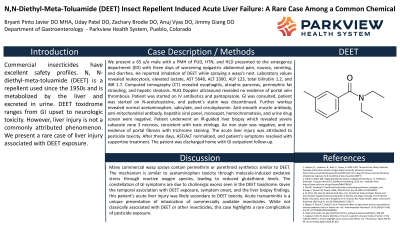Tuesday Poster Session
Category: Liver
P3950 - N-Diethyl-Meta-Toluamide Insect Repellent Induced Acute Liver Failure: A Rare Case Among a Common Chemical
Tuesday, October 24, 2023
10:30 AM - 4:00 PM PT
Location: Exhibit Hall

Has Audio
.jpg)
Bryant Pinto Javier, DO, MHA
Parkview Medical Center
Pueblo, CO
Presenting Author(s)
Bryant Pinto. Javier, DO, MHA1, Uday Patel, DO1, Zachary Brodie, DO2, Anuj Vyas, DO1, Jimmy Giang, DO1
1Parkview Medical Center, Pueblo, CO; 2Rocky Vista University, Greenwood Village, CO
Introduction: Commercial insecticides have excellent safety profiles. N, N-diethyl-meta-toluamide (DEET) is a repellent used since the 1950s and is metabolized by the liver and excreted in urine. DEET toxidrome ranges from GI upset to neurologic toxicity. However, liver injury is not a commonly attributed phenomenon. We present a rare case of liver injury associated with DEET exposure.
Case Description/Methods: We present a 65 y/o male with a PMH of PUD, HTN, and HLD presented to the emergency department (ED) with three days of worsening epigastric abdominal pain, nausea, vomiting, and diarrhea. He reported inhalation of DEET while spraying a wasp's nest. Laboratory values revealed leukocytosis, elevated lactate, AST 5648, ALT 3300, ALP 123, total bilirubin 1.2, and INR 1.7. Computed tomography (CT) revealed esophagitis, atrophic pancreas, perinephric fat stranding, and hepatic steatosis. RUQ Doppler ultrasound revealed no evidence of portal vein thrombosis. Patient was started on IV antibiotics and pantoprazole. GI was consulted, patient was started on N-acetylcysteine, and patient's statin was discontinued. Further workup revealed normal acetaminophen, salicylate, and ceruloplasmin. Anti-smooth muscle antibody, anti-mitochondrial antibody, hepatitis viral panel, monospot, hemochromatosis, and urine drug screen were negative. Patient underwent an IR-guided liver biopsy which revealed severe subacute zone 3 necrosis, consistent with toxic etiology. An iron stain was negative, and no evidence of portal fibrosis with trichrome staining. The acute liver injury was attributed to pesticide toxicity. After three days, AST/ALT normalized, and patient's symptoms resolved with supportive treatment. The patient was discharged home with GI outpatient follow-up.
Discussion: Many commercial wasp sprays contain permethrin or pyrethroid synthetics similar to DEET. The mechanism is similar to acetaminophen toxicity through molecule-induced oxidative stress through reactive oxygen species, leading to reduced glutathione levels. The constellation of GI symptoms are due to cholinergic excess seen in the DEET toxidrome. Given the temporal association with DEET exposure, symptom onset, and the liver biopsy findings, this patient's acute liver injury was likely secondary to DEET toxicity. Acute transaminitis is a unique presentation of intoxication of commercially available insecticides. While not classically associated with DEET or other insecticides, this case highlights a rare complication of pesticide exposure.
Disclosures:
Bryant Pinto. Javier, DO, MHA1, Uday Patel, DO1, Zachary Brodie, DO2, Anuj Vyas, DO1, Jimmy Giang, DO1. P3950 - N-Diethyl-Meta-Toluamide Insect Repellent Induced Acute Liver Failure: A Rare Case Among a Common Chemical, ACG 2023 Annual Scientific Meeting Abstracts. Vancouver, BC, Canada: American College of Gastroenterology.
1Parkview Medical Center, Pueblo, CO; 2Rocky Vista University, Greenwood Village, CO
Introduction: Commercial insecticides have excellent safety profiles. N, N-diethyl-meta-toluamide (DEET) is a repellent used since the 1950s and is metabolized by the liver and excreted in urine. DEET toxidrome ranges from GI upset to neurologic toxicity. However, liver injury is not a commonly attributed phenomenon. We present a rare case of liver injury associated with DEET exposure.
Case Description/Methods: We present a 65 y/o male with a PMH of PUD, HTN, and HLD presented to the emergency department (ED) with three days of worsening epigastric abdominal pain, nausea, vomiting, and diarrhea. He reported inhalation of DEET while spraying a wasp's nest. Laboratory values revealed leukocytosis, elevated lactate, AST 5648, ALT 3300, ALP 123, total bilirubin 1.2, and INR 1.7. Computed tomography (CT) revealed esophagitis, atrophic pancreas, perinephric fat stranding, and hepatic steatosis. RUQ Doppler ultrasound revealed no evidence of portal vein thrombosis. Patient was started on IV antibiotics and pantoprazole. GI was consulted, patient was started on N-acetylcysteine, and patient's statin was discontinued. Further workup revealed normal acetaminophen, salicylate, and ceruloplasmin. Anti-smooth muscle antibody, anti-mitochondrial antibody, hepatitis viral panel, monospot, hemochromatosis, and urine drug screen were negative. Patient underwent an IR-guided liver biopsy which revealed severe subacute zone 3 necrosis, consistent with toxic etiology. An iron stain was negative, and no evidence of portal fibrosis with trichrome staining. The acute liver injury was attributed to pesticide toxicity. After three days, AST/ALT normalized, and patient's symptoms resolved with supportive treatment. The patient was discharged home with GI outpatient follow-up.
Discussion: Many commercial wasp sprays contain permethrin or pyrethroid synthetics similar to DEET. The mechanism is similar to acetaminophen toxicity through molecule-induced oxidative stress through reactive oxygen species, leading to reduced glutathione levels. The constellation of GI symptoms are due to cholinergic excess seen in the DEET toxidrome. Given the temporal association with DEET exposure, symptom onset, and the liver biopsy findings, this patient's acute liver injury was likely secondary to DEET toxicity. Acute transaminitis is a unique presentation of intoxication of commercially available insecticides. While not classically associated with DEET or other insecticides, this case highlights a rare complication of pesticide exposure.
Disclosures:
Bryant Javier indicated no relevant financial relationships.
Uday Patel indicated no relevant financial relationships.
Zachary Brodie indicated no relevant financial relationships.
Anuj Vyas indicated no relevant financial relationships.
Jimmy Giang indicated no relevant financial relationships.
Bryant Pinto. Javier, DO, MHA1, Uday Patel, DO1, Zachary Brodie, DO2, Anuj Vyas, DO1, Jimmy Giang, DO1. P3950 - N-Diethyl-Meta-Toluamide Insect Repellent Induced Acute Liver Failure: A Rare Case Among a Common Chemical, ACG 2023 Annual Scientific Meeting Abstracts. Vancouver, BC, Canada: American College of Gastroenterology.
